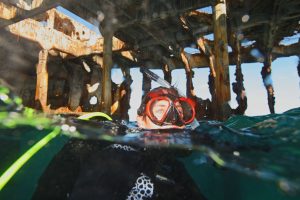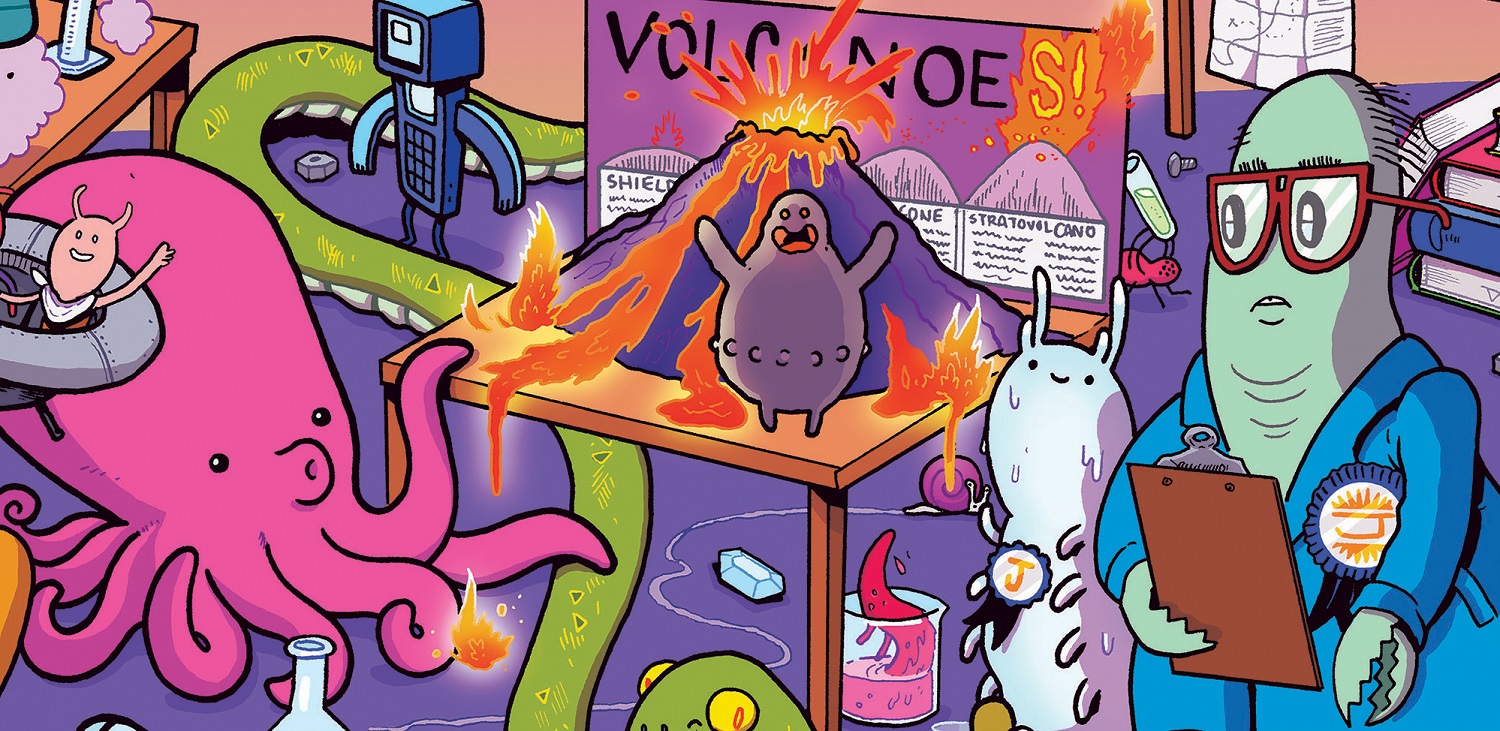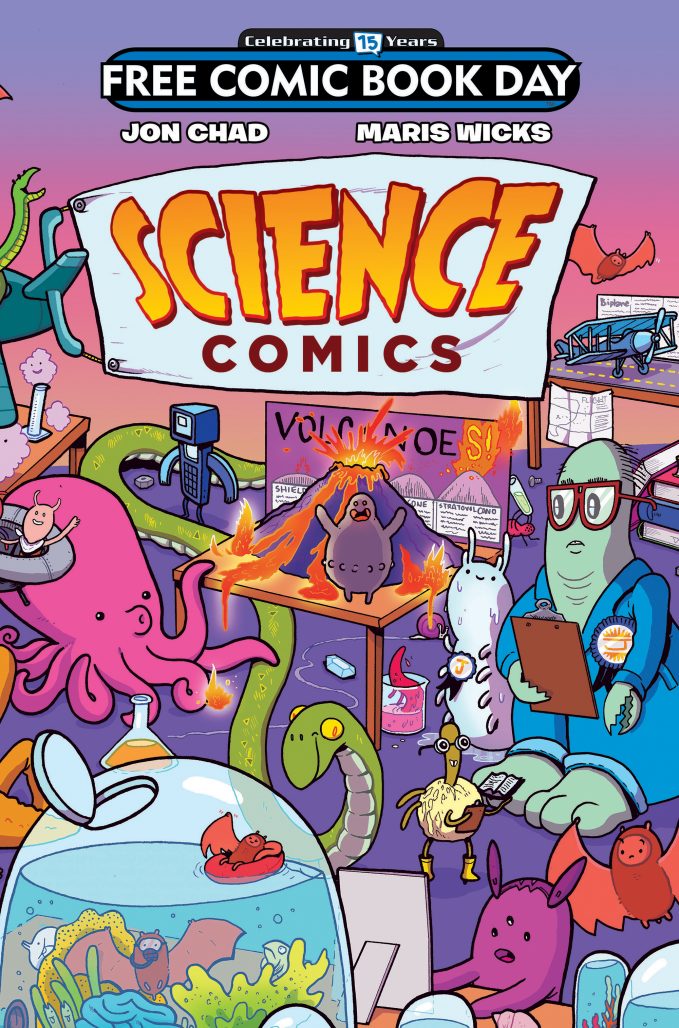When you head into your comic book store this Saturday, you and your kids can pick up a complimentary copy of Science Comics, a pamphlet that introduces readers to First Second’s new non-fiction series about the natural wonders of planet Earth. The Free Comic Book Day special features stories by Jon Chad, who is producing Science Comics: Volcanoes; and Maris Wicks, who is creating Science Comics: Coral Reefs. Wicks’ entry into the series is out now, as is Science Comics: Dinosaurs by MK Reed and Joe Flood.
After the jump, We have special Q&As with Jon Chad and Maris Wicks to get you excited about nature before you head to your local comics shop tomorrow. Enjoy!
Science Comics: Volcanoes

Alex Lu: Jon, I found the post-apocalyptic setting of your FCBD comic to be intriguing and, well– chilling. What drove your decision to use the setting as a narrative framework for your book?
Jon Chad: The initial reasoning was based on the difference between the visuals of a frozen world versus scenes of erupting volcanoes. Book technology hasn’t gotten to the point where I can get the reader to feel actual heat coming off my illustrations, so the next best thing was to use the contrast of a cold setting to make the volcanoes seem as hot as possible. I wanted there to be some technology in the book partially for selfish reasons (I like to draw robots, holograms, etc), but I also really like the idea that in a world that has hover bikes in it, what the characters really get excited about is volcanoes! I love bringing in fiction, but I always try to use it merely to reinforce that fact is just as amazing as fiction!
Lu: You’re clearly a very knowledgeable person about volcanoes! What sparked your interest in the phenomena? Where did you learn all of this information?
Chad: In a round-about way, I think I first got seriously interested in volcanoes when I was reading about Sturzstroms. Sturzstroms are landslides that are so powerful that they can move uphill. They happen a lot on planets with lesser gravity, but they can also be caused on Earth by volcanoes. There was a Sturzstrom when Mt. St. Helens erupted. As I read more about the Mt St Helens eruption, that led me to other volcanoes, and I realized that the power of volcanoes was truly immense and, at times, nearly unbelievable. I got nearly all of my information from books I got at the library. When I started getting serious about volcano research for the book, I started checking my facts with my two friends Gwyneth Hughes (PhD in Geology, MS Geophysics) and Michael Cardiff (Assistant Professor in Geoscience, UW-Madison).
Lu: Have you ever visited a volcano yourself?
Chad: No, I’ve never been to an active volcano to see one erupt in person, but there are two at the top of my list. Mt Stromboli in Italy has been erupting continuously for over 2000 years and is nicknamed “The Lighthouse of the Mediterranean”. The other is Mauna Loa; and active shield volcano in the state of Hawaii. If we measure from the base of where Mauna Loa emerged on the ocean floor, to the height at which it has grown, it’s actually taller than Mt Everest! SO COOL! While Stromboli’s eruptions are flashy and violent, Mauna Loa is calm and slow, but just as hot.
Lu: In a new ice age, volcanoes clearly could serve an important purpose as a heat source. Do you think they could have uses for us in the present?
Chad: Absolutely! There are a number of ways that we are already harnessing the power, heat, and life that come from volcanoes. First, there are some countries, like Iceland, that use the heat of volcanoes to heat their home. Now, it’s not like the volcano runs through their living room. Water-filled pipes are run near areas of volcanic activity and are heated by the volcano. Also, some of the most verdant orchards in the world are near volcanoes. That’s because volcanic soil is incredibly rich in minerals that help plants. Also, besides erupting lava, ash, smoke, and cinders, volcanoes can also sometimes erupt very light rocks filled with tiny holes called pumice. Pumice is used in cleaning products because of their abrasive qualities. That’s only a few of the ways that we use volcanoes!
Science Comics: Coral Reefs

Alex Lu: Maris, your FCBD comic was very touching! I was awestruck by your passion for nature and art. Out of curiosity, what made you decide to go to art school instead of pursuing a degree in something like biology?
Maris Wicks: Thank you! That short story was one of my first times sharing a personal experience through comics (well, one meant for an audience – I keep a comics-journal sketchbook as well). The decision to go to school for art (and not science, or even a school that had a wider selection of academic classes) was a difficult one. I knew that going to RISD (Rhode Island School of Design) would mean getting an incredible art education, but I also felt like I was abandoning science. Fortunately, there were some great resources, like the Nature Lab (it’s like a mini-museum of natural history) and a few science-y courses (I took a great Human Anatomy and Physiology class). Scientific themes also worked their way into lots of my work; it was a passion I just couldn’t avoid!
Lu: Since your first coral reef diving experience, have you gone on other coral reef diving expeditions?
Wicks: I have! I participated in the same collection trip with the New England Aquarium this past year, diving on reefs in the Bahamas to collect fish for their tropical galleries. I did some reef surveys too – that’s where you go down and identify and count fish, and then enter your data on a website – it’s citizen science for coral reef fish populations. I also got the opportunity to snorkel in the Red Sea, off the coast of Saudi Arabia this past January (diving regulations are different there, so I was not able to dive). It was incredible! There has not been much research done on reefs in the Red Sea, and it’s a pretty unique body of water based on its isolation from the larger Pacific Ocean. I have’t dove in the Pacific yet, and I’d love too. I’m working on it :-)
Lu: While it’s clear you have a love for all sea creatures, do you have a favorite?
Wicks: Well, that’s like asking a parent to pick their favorite kid! I have LOTS of favorites…As far as animal groups go, I really like invertebrates (you know, anything without a spine). I feel like they are under-represented because they are often smaller than charismatic marine megafauna (AHEM, I’m looking at YOU, dolphins), and sometimes it’s hard to find their face (sometimes they don’t even have a face!). My favorite inverts are nudibranch (sea slugs) and snails. As far as fish go, it’s a toss up between pufferfish/porcupinefish and garden eels. Usually if an animal is covered in mucus, or it looks funny, I love it.
Lu: In our daily lives, what are some of the things we can do to help take care of coral reefs and oceans?
Wicks: Just being interested in and learning more about our oceans is a great start! There are personal choices that you can make, like reducing your waste (using reusable water bottles/coffee mugs/lunch bags, composting, recycling), and cutting down on fuel (carpooling, biking/walking, using public transit; setting your thermostat to efficiently cool/warm your living space). It might not seem like much if it’s just you doing these things, but if even a quarter of the country did them, it would have a HUGE impact!
If you have an animal or habitat that you feel strongly about supporting, consider donating to an organization that helps protect and preserve the environment. Volunteering is a great way to get activity involved – beach clean-ups, citizen science events (like biodiversity scavenger hunts!), organizations like aquariums or conservation groups – these are all great ways to get out and get connected to nature.
If you’re looking for even more stuff to do, stay informed about legislation. Laws about everything from habitat and individual species protection to plastic and oil consumption to sustainable fishing practices have an impact on the ocean. Voting on these issues, or even writing your local government can help to shape our relationship with the ocean, and in turn, our environment. Earth’s a pretty great planet, and I hope we can keep it that way.
Science Comics: Volcanoes comes out this fall. Science Comics: Coral Reefs and Science Comics: Dinosaurs will be available when you head to your comics store on Saturday. Remember to pick up a copy of the free Science Comics pamphlet when you go!
Happy Free Comic Book Day!









